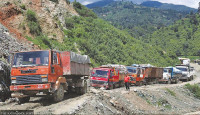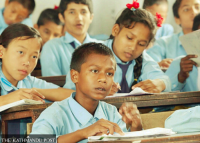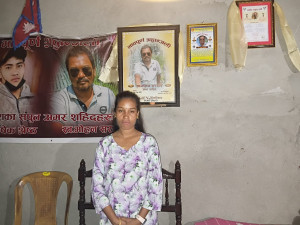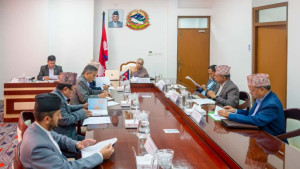Opinion
Not enough to eat
Food scarcity has impact on social, economic, cultural and educational aspects of public life
Raj Pariyar
Most districts in Nepal face a food deficit every year. The number of people who produce enough food for themselves is low. In addition, there are not adequate food warehouses, and the few that are available are not well managed or in regular operation. Meanwhile, local businesspersons are unable to fulfil the food demand, particularly in the mountain and hill areas. With regard to access, poor and marginalised people, Dalits and women are still underprivileged in terms of resources such as water, forest and land. The available food is not being properly utilised owing to inadequate drinking water, health facilities and sanitation. Crop yields are low mainly due to the impact of climate change, drought, infertility and wildlife hazards.
Causes
One of the reasons behind food insecurity is physiography. The hill and mountain land forms are young, unconsolidated and fragile. They have a steep gradient, intense precipitation and thin vegetation. The hill and mountain regions have rugged topography, complex geographical structures, very high relief and variability in terms of climate conditions. Consequently, food production is low. Another parameter is land size. A majority of the people in Nepal are small farmers. In this context, small landholders and land poor farmers cannot produce large crops round the year. Similarly, 73.9 percent of the households in Nepal own land while the rest are landless. Increasing land fragmentation has also led to low production of crops.
Irrigation facilities are not available throughout the country. Only 37.7 percent of the farmlands in the mountains, 40.9 percent in the hills and 69.1 percent in the Tarai have access to irrigation. There are vast lands where irrigation facilities can be provided. Large crops are not possible without irrigation. The monsoon dependent paddy cropping system is being abandoned in rural areas. The population has been declining in the mountains and hills over the years. About 20 percent of the people have migrated for employment. The proportion of the absentee population is higher in the mountains and hills, particularly in the 15-29 age group. Consequently, the economically inactive dependent population has been swelling while rural farmers are facing a shortage of farm labour. The food habits of migrant families have changed. They eat readymade food instead of growing their own. So people are gradually moving away from agricultural activities. This has led to people being dependent on imported food.
Wildlife hazards are also a major reason behind food insecurity. Farmers whose fields are close to jungles face attacks by wild animals. Monkeys, bears, rabbits, porcupines, wild pigs and crows damage their crops. These farmers have given up farming activities as a result. It has been reported that 50 percent of the farmlands in Langtang are lying uncultivated due to the threat of wild pigs.
Climate change is yet another factor behind food insecurity in the present context. About 86 percent of the people in Nepal live in rural areas. An overwhelming majority of the rural population depend on agriculture for their livelihood. Climate change mostly affects rural farmers who lack the means to fight its effects. Early and late monsoons, heavy and incessant rainfall, drought and irregular rainfall affect the production of crops.
Natural factors like soil erosion, silt deposition, inundation, flood and landslide play a major role in shrinking farmlands and outputs. The hills and mountains are highly vulnerable to water induced disasters such as landslide, soil erosion, debris flow and slope failure. Consequently, people do not have enough land for farming. In the hill and mountain districts, food production is low while prices are constantly rising due to their remoteness. Most hill areas are still a long way off from motorable roads. Food is transported by porters, mules, horses and yaks over long and difficult trails. Sometimes, rural areas are hit by disease outbreaks which create a famine situation.
According to Nepal Living Standard Survey 2010-11, 25.16 percent of the population lives under the poverty line. Dalits and Janajatis have a high poverty rate of 43.6 percent and 28.3 percent respectively. Employment opportunities are few in rural districts. People have limited sources of income. Dalits, Muslims and Madhesis have the lowest per capita income. Poverty is a crucial factor in food insecurity. Farmers lack adequate technical skills about farm management, production technology, productivity of farming systems, choice of breeds, crossbreeds and types of animals, effective control of diseases in rural areas and improved feed and fodder. Farmers have little knowledge about the facilities provided by service providers.
Furthermore, government incentives and loan policies are unclear and insufficient. Small landholders have problems of collateral. The government has issued many policies about food security, right to food, agricultural development, climate change and disaster risk management, but their implementation is weak. They have not incorporated the voice of poor and marginalised people, Dalits, small landholders, landless farmers, Janajatis and Madhesis for ensuring food security.
Consequences
Inadequate food has led to various health and development related impacts. Malnutrition and under-nutrition issues remain, and 31 percent of the children under five years are underweight while eight percent of the children are severely underweight. The problem is twice as bad in rural areas. Similarly, 42 percent of the children are stunted while 15 percent are severely stunted. The rate of stunting in the mountains is a high 56 percent. Another impact of food scarcity in Nepal is wasting disease which affects about 14 percent of the children. There are various social, economic, cultural and educational impacts of food scarcity.
Pariyar holds a postgraduate degree in geography from Tribhuvan University




 17.12°C Kathmandu
17.12°C Kathmandu










